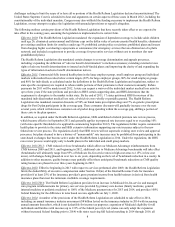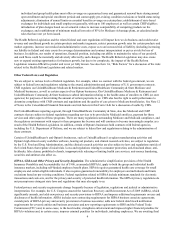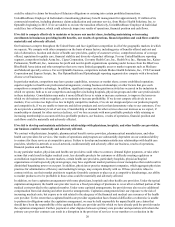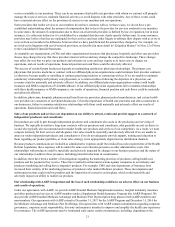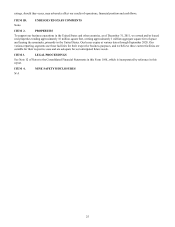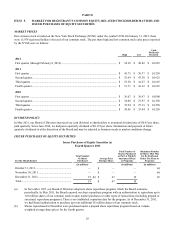United Healthcare 2011 Annual Report Download - page 20
Download and view the complete annual report
Please find page 20 of the 2011 United Healthcare annual report below. You can navigate through the pages in the report by either clicking on the pages listed below, or by using the keyword search tool below to find specific information within the annual report.18
be entitled to various quality bonus payments. There can be no assurance that any of our plans will meet these quality ratings.
Our revenues, results of operations, financial position and cash flows could be materially and adversely affected by funding
reductions, or if our plans do not meet the requirements to receive quality bonus payments. Similarly, any reduction in
Medicare Advantage payments could result in downward pressure on payments made to our Collaborative Care business in
exchange for services provided to Medicare Advantage plans.
Our participation in the Medicare Advantage, Medicare Part D, and various Medicaid and CHIP programs occurs through bids
that are submitted periodically. Revenues for these programs are dependent upon periodic funding from the federal government
or applicable state governments and allocation of the funding through various payment mechanisms. Funding for these
government programs is dependent upon many factors outside of our control, including general economic conditions and
budgetary constraints at the federal or applicable state level, and general political issues and priorities. A reduction or less than
expected increase, or a protracted delay, in government funding for these programs or change in allocation methodologies may
materially and adversely affect our revenues, results of operations, financial position and cash flows. State Medicaid programs
are also imposing other reforms, such as medical loss ratio requirements on Medicaid managed care organizations, which
generally require such plans to rebate ratable portions of their premiums to their state customers if they cannot demonstrate
they have met the ratio standards.
CMS uses various payment mechanisms to allocate funding for Medicare programs, including adjusting monthly capitation
payments to Medicare Advantage plans and Medicare Part D plans according to the predicted health status of each beneficiary
as supported by data from health care providers as well as, for Medicare Part D plans only, based on comparing costs predicted
in our annual bids to actual prescription drug costs. Some state Medicaid programs utilize a similar process. For example, our
UnitedHealthcare Medicare & Retirement and UnitedHealthcare Community & State businesses submit information relating to
the health status of enrollees to CMS or state agencies for purposes of determining the amount of certain payments to us. In
2008, CMS announced that it will perform risk adjustment data validation (RADV) audits of selected Medicare health plans
each year to validate the coding practices of and supporting documentation maintained by health care providers, and certain of
our local plans have been selected for audit. These audits may result in retrospective adjustments to payments made to our
health plans. In December 2010, CMS published for public comment a new proposed RADV audit and payment adjustment
methodology. The proposed methodology contains provisions allowing retroactive contract level payment adjustments for the
year audited using an extrapolation of the “error rate” identified in audit samples. In February 2011, CMS announced that it
would be making changes to the proposed methodology based, in part, on comments submitted by industry participants. As of
the date of this filing, CMS has not published the revised methodology. Depending on the methodology utilized, potential
payment adjustments could have a material adverse effect on our results of operations, financial position and cash flows.
In addition, the Office of Inspector General for HHS has audited our risk adjustment data for two local plans and has initially
communicated its findings, although we cannot predict the final outcome of the audit process. Any payment adjustments
required as a result of the audits or otherwise could have a material adverse effect on our results of operations, financial
position and cash flows. See Note 12 of Notes to the Consolidated Financial Statements in this Form 10-K for additional
information regarding these audits.
CMS conducts a variety of routine, regular and special investigations, audits and reviews across the industry. For example, in
the fourth quarter of 2011, CMS conducted an audit of our Medicare Advantage and Part D business. We are in the process of
responding to preliminary findings. As with any CMS review, in the event we fail to comply with applicable CMS and state
laws, regulations and rules, our results of operations, financial position and cash flows could be materially and adversely
affected.
Under the Medicaid Managed Care program, state Medicaid agencies are periodically required by federal law to seek bids from
eligible health plans to continue their participation in the acute care Medicaid health programs. If we are not successful in
obtaining renewals of state Medicaid Managed Care contracts, we risk losing the members that were enrolled in those Medicaid
plans. Under the Medicare Part D program, to qualify for automatic enrollment of low income members, our bids must result in
an enrollee premium below a regional benchmark, which is calculated by the government after all regional bids are submitted.
If the enrollee premium is not below the government benchmark, we risk losing the members who were auto-assigned to us and
we will not have additional members auto-assigned to us. For example, we lost approximately 470,000 of our auto-enrolled
low-income subsidy members effective January 1, 2012, because certain of our bids exceeded thresholds set by the
government. In general, our bids are based upon certain assumptions regarding enrollment, utilization, medical costs, and other
factors. In the event any of these assumptions are materially incorrect, either as a result of unforeseen changes to the Medicare
program or other programs on which we bid, or our competitors submit bids at lower rates than our bids, our results of
operations, financial position and cash flows could be materially and adversely affected.


